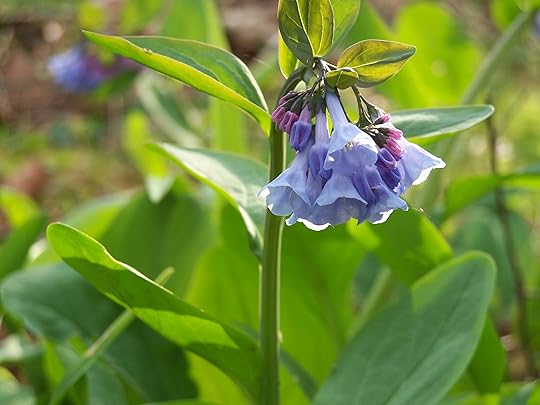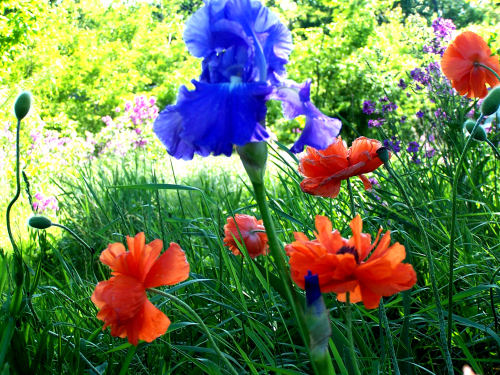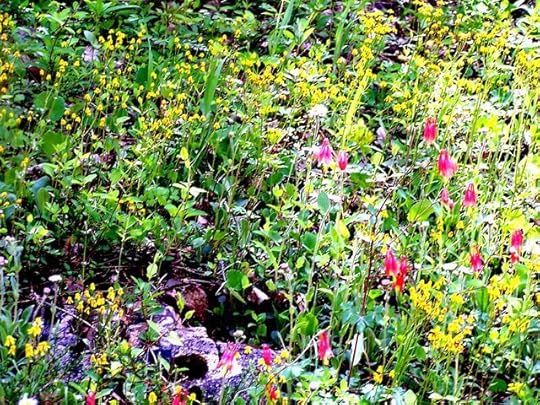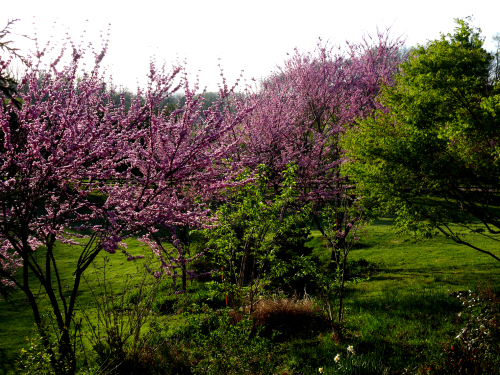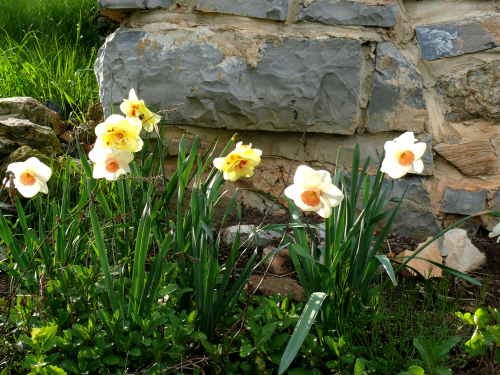Beth Trissel's Blog, page 98
April 8, 2011
The Setting & Inspiration for Native American Historical Romance Through the Fire
 THROUGH THE FIRE opens in 1758 at the height of the French and Indian War in the Allegheny Mountains in what is now West Virginia, but was western Virginia then. The state wasn't divided until the Civil War when West Virginia broke away and joined the union as a separate state. But that's another story. At the time of THROUGH THE FIRE, the Virginia colonial frontier was vast. The fort assault in the story is a compilation of assaults I researched with the invaluable aid of a local anthropologist/archeologist who goes on frequent digs to try to discover the sites of these old Virginia forts.
THROUGH THE FIRE opens in 1758 at the height of the French and Indian War in the Allegheny Mountains in what is now West Virginia, but was western Virginia then. The state wasn't divided until the Civil War when West Virginia broke away and joined the union as a separate state. But that's another story. At the time of THROUGH THE FIRE, the Virginia colonial frontier was vast. The fort assault in the story is a compilation of assaults I researched with the invaluable aid of a local anthropologist/archeologist who goes on frequent digs to try to discover the sites of these old Virginia forts.
 The number of Catawba warriors involved in the novel is a stretch as there were never that many taking part in a pitched battle in Virginia, however the tribe fought for the British during the French and Indian War, and were fierce enemies of the Shawnee. Plus the Catawba often sent war parties into the Virginia frontier. The warriors thought nothing of traipsing from their home base in the Carolinas to kick but in Virginia and farther north. A hardy, resourceful, and tenacious people as were other tribes such as the Shawnee whom I feature in my work .
The number of Catawba warriors involved in the novel is a stretch as there were never that many taking part in a pitched battle in Virginia, however the tribe fought for the British during the French and Indian War, and were fierce enemies of the Shawnee. Plus the Catawba often sent war parties into the Virginia frontier. The warriors thought nothing of traipsing from their home base in the Carolinas to kick but in Virginia and farther north. A hardy, resourceful, and tenacious people as were other tribes such as the Shawnee whom I feature in my work .

In the movie, The Last of the Mohicans, the story supposedly takes place in the colonial frontier in New York State, but was actually filmed in Chimney Rock State Park in North Carolina which the producers felt most closely resembled the Adirondack Mountains. Some of the scenes took place across the valley in what was once known as Carson City and Hickory Nut Flats. For more on the setting for the movie click here.
A great deal of conflict with Native Americans occurred in the Virginia frontier–more than we know because people were too busy fighting to survive to record it all. Historian Joseph Waddell says we know only a fraction of the drama that occurred in the Virginia frontier during the Indian Wars. Historians can only conjecture as to the rest of it all.
 One point I disagree with in the film is the implication that the only land available to poor people was somewhere farther north in New York State. Heck, plenty of Scots-Irish headed back into the Alleghenies to stake out homesteads and erect forts. Other than this, I felt the film was mostly correct and is one of my all-time favorites.
One point I disagree with in the film is the implication that the only land available to poor people was somewhere farther north in New York State. Heck, plenty of Scots-Irish headed back into the Alleghenies to stake out homesteads and erect forts. Other than this, I felt the film was mostly correct and is one of my all-time favorites.
 Back to THROUGH THE FIRE, the opening was inspired by a dream in which I saw the heroine, Rebecca, her sister Kate, the attack on the frontiersmen the women were traveling with, Rebecca's fall from the horse, Kate's escape on her mount, and the hero, Shoka's, arrival on the scene. All of this made a vivid impression on me. Also, that Shoka didn't approve of Rebecca.
Back to THROUGH THE FIRE, the opening was inspired by a dream in which I saw the heroine, Rebecca, her sister Kate, the attack on the frontiersmen the women were traveling with, Rebecca's fall from the horse, Kate's escape on her mount, and the hero, Shoka's, arrival on the scene. All of this made a vivid impression on me. Also, that Shoka didn't approve of Rebecca.
Research on top of research, yet more dreams, and inspiration followed to bring this novel to completion, along with the help of historians and the Shawnee themselves. A letter I came across from Virginia's Governor Dinwiddie (a prodigious letter writer) asking what happened to the militia he sent out from Fort Loudon in Winchester to a fort in the interior of the Virginia frontier also lent inspiration to the 'what ifs' behind the novel.
 Yes, this adventure romance has a The Last of the Mohicans flavor, but it was never my intent to reproduce that story, and many elements of Through the Fire are quite different, including its mystical weave. Research into my colonial American roots were the initial impetus for the leap into writing this and my other American historical romances.
Yes, this adventure romance has a The Last of the Mohicans flavor, but it was never my intent to reproduce that story, and many elements of Through the Fire are quite different, including its mystical weave. Research into my colonial American roots were the initial impetus for the leap into writing this and my other American historical romances.
My fascination with stirring tales of the colonial frontier and Eastern Woodland Indians is an early and abiding one. My English/Scot-Irish ancestors were among the first settlers of the Shenandoah Valley and had family members killed and captured by the Indians. Some people returned and left intriguing accounts of their captivity, while others disappeared without a trace. On the Houston-Rowland side of the family, I have ties to Governor Sam Houston, President James Madison and Malcolm 1st of Scotland.
 Family annals list early names like Beale, Jordan, Madison, and Hite (a German connection I discovered). A brief account of my grandmother (nine generations removed) Elizabeth Hite, says her sister Eleanor was taken captive and sister Susan killed, though not by which tribe. Their brother Jacob was killed by the Cherokee in South Carolina.
Family annals list early names like Beale, Jordan, Madison, and Hite (a German connection I discovered). A brief account of my grandmother (nine generations removed) Elizabeth Hite, says her sister Eleanor was taken captive and sister Susan killed, though not by which tribe. Their brother Jacob was killed by the Cherokee in South Carolina.
 Another ancestor, Mary Moore, is the subject of a book entitled The Captives of Abb's Valley. A Moffett forebear captured as a child became a boyhood companion of the revered Shawnee Chief Tecumseh. When young Moffett grew up, he married into the tribe and had a son, the inspiration behind my Native American historical romance novel Red Bird's Song. An ancestor on the Churchman side of the family was invited by the Shawnee/Delaware tribes to help negotiate a treaty with the English because he was Quaker and more sympathetic to their plight.
Another ancestor, Mary Moore, is the subject of a book entitled The Captives of Abb's Valley. A Moffett forebear captured as a child became a boyhood companion of the revered Shawnee Chief Tecumseh. When young Moffett grew up, he married into the tribe and had a son, the inspiration behind my Native American historical romance novel Red Bird's Song. An ancestor on the Churchman side of the family was invited by the Shawnee/Delaware tribes to help negotiate a treaty with the English because he was Quaker and more sympathetic to their plight.
In THROUGH THE FIRE, I invite you to journey back to a dramatic and fascinating time long forgotten by most.

2009 PUBLISHER'S WEEKLY BHB READER'S CHOICE BEST BOOKS

THE FRENCH AND INDIAN WAR, A SHAWNEE WARRIOR, AN ENGLISH LADY, BLOOD VENGEANCE, DEADLY PURSUIT, PRIMAL, POWERFUL, PASSIONATE

Filed under: Uncategorized Tagged: Allegheny Mountains, American Civil War, Chimney Rock State Park, Civil War, French and Indian War, Historical romance novel, Last of the Mohicans, Native American Historical Romance novel, New York, North Carolina, Shenandoah Valley, United States, Virginia, West Virginia








April 7, 2011
"Every spring is the only spring-a perpetual astonishment."~Ellis Peters
"Spring has returned. The Earth is like a child that knows poems." ~Rainer Maria Rilke
Awake, thou wintry earth -
Fling off thy sadness!
Fair vernal flowers, laugh forth
Your ancient gladness!
~Thomas Blackburn, "An Easter Hymn"
*The Shenandoah Valley of Virginia. Photographs by my mom, Pat Churchman
"April is a promise that May is bound to keep." ~Hal Borland
"Where man sees but withered leaves,
God sees sweet flowers growing."
~Albert Laighton
"And Spring arose on the garden fair,
Like the Spirit of Love felt everywhere;
And each flower and herb on Earth's dark breast
rose from the dreams of its wintry rest."
~Percy Bysshe Shelley, "The Sensitive Plant"
*Virginia Bluebells in my garden, flowers given to me by my grandmother.
"I think that no matter how old or infirm I may become, I will always plant a large garden in the spring. Who can resist the feelings of hope and joy that one gets from participating in nature's rebirth?" ~Edward Giobbi
"The sun was warm but the wind was chill.
You know how it is with an April day."
~Robert Frost
*Poppies and iris in the garden.
"April hath put a spirit of youth in everything." ~William Shakespeare
"Yesterday the twig was brown and bare;
To-day the glint of green is there;
Tomorrow will be leaflets spare;
I know no thing so wondrous fair,
No miracle so strangely rare.
I wonder what will next be there!"
~L.H. Bailey
"If I had my life to live over, I would start barefoot earlier in the spring and stay that way later in the fall." ~Nadine Stair
*Country Lane in the valley.
"Spring in verses,
Verses in spring."
~Violet Gartenlicht
"Now every field is clothed with grass, and every tree with leaves; now the woods put forth their blossoms, and the year assumes its gay attire." ~Virgil
*A country roadside not far from our farm.
"The day the Lord created hope was probably the same day he created Spring."
~Bern Williams
"Spring is when life's alive in everything."
~Christina Rossetti
"The year's at the spring,
And day's at the morn;
Morning's at seven;
The hill-side's dew-pearl'd;
The lark's on the wing;
The snail's on the thorn;
God's in His heaven–
All's right with the world!"
~Robert Browning
*My parent's yard.
"A little Madness in the Spring
Is wholesome even for the King."
~Emily Dickinson
"Spring unlocks the flowers to paint the laughing soil."
~Bishop Reginald Heber
"I wandered lonely as a cloud
That floats on high o'er vales and hills,
When all at once I saw a crowd,
A host, of golden daffodils."
~William Wordsworth
Filed under: Uncategorized Tagged: Earth, Easter, Edward Giobbi, Flower, Garden, Hal Borland, Percy Bysshe Shelley, Rainer Maria Rilke, Robert Frost, ShenandoahValley, Thomas Blackburn, Virginia, Virginia Bluebell, William Shakespeare, William Wordsworth








April 6, 2011
Pennyroyal
 Pennyroyal: I love the scent of this creeping plant, wonderfully intense and fragrant. Powerfully minty. I've grown pennyroyal from time to time but haven't found it to be as winter hardy as other mints, nor is it as able to compete and tends to get crowded out if we don't watch. So I need to find new plants. After last summer's searing drought, I have to replace some other herbs and flowers as well.
Pennyroyal: I love the scent of this creeping plant, wonderfully intense and fragrant. Powerfully minty. I've grown pennyroyal from time to time but haven't found it to be as winter hardy as other mints, nor is it as able to compete and tends to get crowded out if we don't watch. So I need to find new plants. After last summer's searing drought, I have to replace some other herbs and flowers as well.
Although pennyroyal is sometimes drunk as tea (though not by me) it can cause uterine contractions and should never be imbibed by pregnant women. It has long been used to intentionally cause abortions. *Under no conditions ever take the essential oil internally! It's a deadly poison.
A warning from this site: http://www.teainfusion.com/types/pennyroyal-tea.html
"When making pennyroyal tea, only the pennyroyal herb should be used. The essential oil of pennyroyal should NOT be used, as it is a poison. Death from untreatable organ failure can result if the essential oil is used."
*Please bear in mind, as with all other medicinal information given to you in this series, that these practices are not necessarily condoned today. Some would be strongly frowned upon and are related strictly in a historical sense.
 From A Modern Herbal:
From A Modern Herbal:
Pennyroyal is the smallest of the Mints and very different in habit from any of the others. Two forms of the plant are met with in Great Britain. The plant has been introduced into North and South America. It is mentioned in the Herbals of the New World as one of the plants the Pilgrim Fathers introduced.
It is found wild and naturalized throughout the civilized world in strong, moist soil on the borders of ponds and streams, and near pools on heaths and commons. Gerard speaks of it as found abundantly:
'on a common at Mile End, near London, about the holes and ponds thereof, in sundrie places, from whence poore women bring plenty to sell in London markets.'
 Turner says: 'It crepeth much upon the ground and hath many little round leves not unlyke the leves of mesierum gentil, but that they are a little longer and sharper and also little indented rounde about, and grener than the leves of mariurum ar. The leves grow in little branches even from the roote of certayn ioyntes by equall spaces one devyded from an other. Whereas the leves grow in little tuftes upon the over partes of the braunches…. Pennyroyal groweth much, without any setting, besyd hundsley (Hounslow) upon the heth beside a watery place.'
Turner says: 'It crepeth much upon the ground and hath many little round leves not unlyke the leves of mesierum gentil, but that they are a little longer and sharper and also little indented rounde about, and grener than the leves of mariurum ar. The leves grow in little branches even from the roote of certayn ioyntes by equall spaces one devyded from an other. Whereas the leves grow in little tuftes upon the over partes of the braunches…. Pennyroyal groweth much, without any setting, besyd hundsley (Hounslow) upon the heth beside a watery place.'
Like most of its near relatives, Pennyroyal is highly aromatic, perhaps even more so than any other Mint, containing an essential oil resembling in properties that of other mints, though less powerful. The flavour is more pungent and acrid and less agreeable than that of Spearmint or Peppermint.
Pennyroyal was in high repute among the Ancients. Both Pliny and Dioscorides described its numerous virtues. In Northern Europe it was also much esteemed, as may be inferred from the frequent references to it in the Anglo-Saxon and Welsh works on medicine.
'The boke of Secretes of Albertus Magnus of the vertues of Herbes, Stones and certaine Beastes' states that, by putting drowning flies and bees in warm ashes of Pennyroyal 'they shall recover their Iyfe after a little tyme as by ye space of one houre' and be revived.
 Pennyroyal is often found in cottage gardens, as an infusion of the leaves, known as Pennyroyal Tea, is an old-fashioned remedy for colds and menstrual derangements.
Pennyroyal is often found in cottage gardens, as an infusion of the leaves, known as Pennyroyal Tea, is an old-fashioned remedy for colds and menstrual derangements.
Medicinal Action and Uses: Pliny gives a long list of disorders for which Pennyroyal was a supposed remedy, and especially recommends it for hanging in sleeping rooms, it being considered by physicians as more conducive to health even than roses.
It was likewise thought to communicate its purifying qualities to water, and Gerard tells us: 'If you have Pennyroyale in great quantity dry and cast it into corrupt water, it helpeth it much, neither will it hurt them that drink thereof.' As a purifier of the blood, it was highly spoken of: 'Penny-royale taken with honey cleanseth the lungs and cleareth the breast from all gross and thick humours.'
It was deemed by our ancestors valuable in headaches and giddiness. We are told: 'A garland of Penny-royale made and worn about the head is of great force against the swimming in the head and the pains and giddiness thereof.'
Pennyroyal Water was distilled from the leaves and given as an antidote to spasmodic, nervous and hysterical affections. It was also used against cold and 'affections of the joints.'
'Drank with wine, it is good for venomous bites, and applied to the nostrils with vinegar revives those who faint and swoon. Dried and burnt, it strengthens the gums, helps the gout, if applied of itself to the place until it is red, and applied in a plaster, it takes away spots or marks on the face; applied with salt, it profits those that are splenetic, or liver grown…. The green herb bruised and putinto vinegar, cleanses foul ulcers and takes away the marks of bruises and blows about the eyes, and burns in the face, and the leprosy, if drank and applied outwardly…. One spoonful of the juice sweetened with sugar-candy is a cure for hooping-cough.'
Its action is carminative, diaphoretic, stimulant and emmenagogic, and is principally employed for the last-named property in disorders caused by sudden chill or cold. It is also beneficial in cases of spasms, hysteria, flatulence and sickness, being very warming and grateful to the stomach.~
Filed under: Uncategorized Tagged: Albertus Magnus, Essential oil, Health, Herb, herb cottage garden, herb garden, London, Maud Grieve, New World, Northern Europe, Pennyroyal








April 3, 2011
Catnip
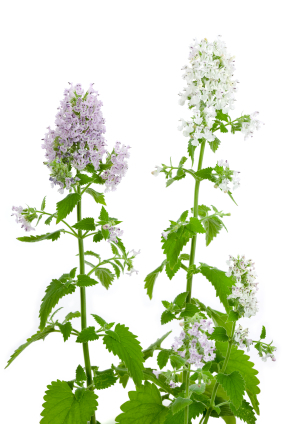 CATNIP: I like catnip. We've grown it for years whether intentionally or not. It comes back freely. Yes, our cats like it but not to the point of ecstasy. It's a member of the mint family but has a distinctively different scent. A hardy, upright, perennial, it has sturdy stems bearing hairy, heart-shaped, grayish-green leaves. The flowers are white or lilac and occur in several clusters toward the tips of the branches. Catnip is a native of Eurasia, naturalized in North America so that it seems as if it's always grown here.
CATNIP: I like catnip. We've grown it for years whether intentionally or not. It comes back freely. Yes, our cats like it but not to the point of ecstasy. It's a member of the mint family but has a distinctively different scent. A hardy, upright, perennial, it has sturdy stems bearing hairy, heart-shaped, grayish-green leaves. The flowers are white or lilac and occur in several clusters toward the tips of the branches. Catnip is a native of Eurasia, naturalized in North America so that it seems as if it's always grown here.
From A Modern Herbal:
Catmint: Nepeta cataria, Catmint or Catnep, a wild English plant belonging to the large family Labiatae, of which the Mints and Deadnettles are also members, is generally distributed throughout the central and the southern counties of England, in hedgerows, borders of fields, and on dry banks and waste ground, especially in chalky and gravelly soil. It is less common in the north, very local in Scotland and rare in Ireland, but of frequent occurrence in the whole of Europe and temperate Asia, and also common in North America, where originally. However, it was an introduced species.
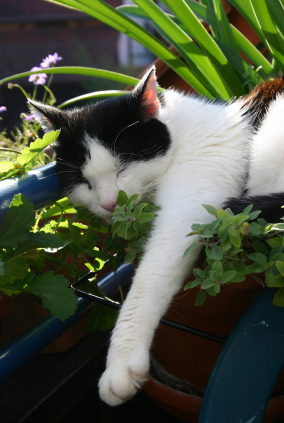 History: The plant has an aromatic, characteristic odour, which bears a certain resemblance to that of both Mint and Pennyroyal. It is owing to this scent that it has a strange fascination for cats, who will destroy any plant of it that may happen to be bruised. There is an old saying about this plant:
History: The plant has an aromatic, characteristic odour, which bears a certain resemblance to that of both Mint and Pennyroyal. It is owing to this scent that it has a strange fascination for cats, who will destroy any plant of it that may happen to be bruised. There is an old saying about this plant:
'If you set it, the cats will eat it,
If you sow it, the cats don't know it.'
And it seems to be a fact that plants transplanted are always destroyed by cats unless protected, but they never meddle with the plants raised from seed, being only attracted to it when it is in a withering state, or when the peculiar scent of the plant is excited by being bruised in gathering or transplanting.
In France the leaves and young shoots are used for seasoning, and it is regularly grown amongst kitchen herbs for the purpose. Both there and in this country, it has an old reputation for its value as a medicinal herb. Miss Bardswell, in The Herb Garden, writes of Catmint:
'Before the use of tea from China, our English peasantry were in the habit of brewing Catmint Tea, which they said was quite as pleasant and a good deal more wholesome. Ellen Montgomery in The Wide, Wide World made Catmint Tea for Miss Fortune when she was ill. It is stimulating. The root when chewed is said to make the most gentle person fierce and quarrelsome, and there is a legend of a certain hangman who could never screw up his courage to the point of hanging anybody till he had partaken of it. Rats dislike the plant particularly, and will not approach it even when driven by hunger.'
This dislike of rats for Catmint might well be utilized by growing it round other valuable crops as a protective screen.
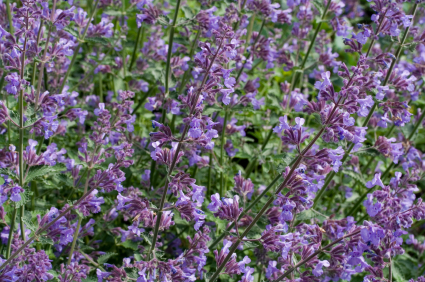 Medicinal Action and Uses: Carminative, tonic, diaphoretic, refrigerant and slightly emmenagogue, specially antispasmodic, and mildly stimulating.
Medicinal Action and Uses: Carminative, tonic, diaphoretic, refrigerant and slightly emmenagogue, specially antispasmodic, and mildly stimulating.
Producing free perspiration, it is very useful in colds. Catnep Tea is a valuable drink in every case of fever, because of its action in inducing sleep and producing perspiration without increasing the heat of the system. It is good in restlessness, colic, insanity and nervousness, and is used as a mild nervine for children, one of its chief uses being, indeed, in the treatment of children's ailments. The infusion of 1 OZ. to a pint of boiling water may be taken by adults in doses of 2 tablespoonsful, by children in 2 or 3 teaspoonsful frequently, to relieve pain and flatulence. An injection of Catnep Tea is also used for colicky pains.
The herb should always be infused, boiling will spoil it. Its qualities are somewhat volatile, hence when made it should be covered up.
The tea may be drunk freely, but if taken in very large doses when warm, it frequently acts as an emetic.
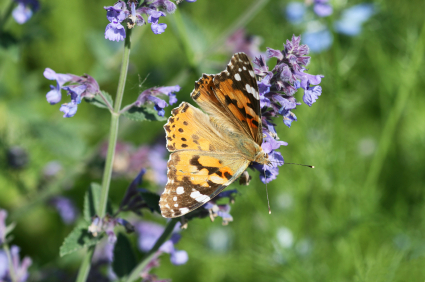 It has proved efficacious in nervous headaches and as an emmenagogue, though for the latter purpose, it is preferable to use Catnep, not as a warm tea, but to express the juice of the green herb and take it in tablespoonful doses, three times a day.
It has proved efficacious in nervous headaches and as an emmenagogue, though for the latter purpose, it is preferable to use Catnep, not as a warm tea, but to express the juice of the green herb and take it in tablespoonful doses, three times a day.
An injection of the tea also relieves headache and hysteria, by its immediate action upon the sacral plexus. The young tops, made into a conserve, have been found serviceable for nightmare.
Catnep may be combined with other agents of a more decidedly diaphoretic nature. Equal parts of warm Catnep tea and Saffron are excellent in scarlet-fever and small-pox, as well as colds and hysterics. It will relieve painful swellings when applied in the form of a poultice or fomentation.
 Old writers recommended a decoction of the herb, sweetened with honey for relieving a cough, and Culpepper tells us also that 'the juice drunk in wine is good for bruises,' and that 'the green leaves bruised and made into an ointment is effectual for piles,' and that 'the head washed with a decoction taketh away scabs, scurf, etc.'
Old writers recommended a decoction of the herb, sweetened with honey for relieving a cough, and Culpepper tells us also that 'the juice drunk in wine is good for bruises,' and that 'the green leaves bruised and made into an ointment is effectual for piles,' and that 'the head washed with a decoction taketh away scabs, scurf, etc.'
Filed under: Uncategorized Tagged: Carminative, Cat, catmint, catnip, Eurasia, Herb, Lamiaceae, Maud Grieve, Nepeta cataria, Plant, Wide Wide World








March 31, 2011
My Solution to World Peace
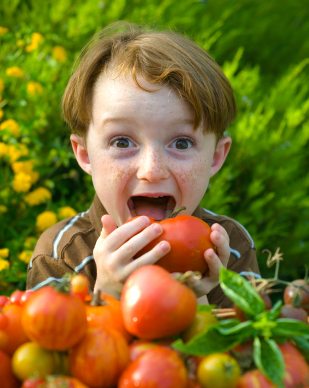 This will come as no surprise to those of you who follow my blog, but I strongly feel and emphatically declare the world would be a far better place if everyone had a garden. I'm convinced when people are growing things, they're much less prone to destructive behavior. Granted, violent extremists (and serial killers) seem beyond redemption, but the rest of humanity would gain immeasurably from a connection with the earth. To cultivate a garden is to commune with the essence of life and the source of all creation.
This will come as no surprise to those of you who follow my blog, but I strongly feel and emphatically declare the world would be a far better place if everyone had a garden. I'm convinced when people are growing things, they're much less prone to destructive behavior. Granted, violent extremists (and serial killers) seem beyond redemption, but the rest of humanity would gain immeasurably from a connection with the earth. To cultivate a garden is to commune with the essence of life and the source of all creation.
"The best place to seek God is in a garden. You can dig for him there. " ~George Bernard Shaw
 I urge planting herbs, vegetables, fruits and flowers in an outdoor plot–convert a patch of lawn if need be–or as part of a community garden. This is a particularly good idea because it brings together people of all ages, from the very young to the elderly, and provides wonderful learning opportunities for children while tapping into the storehouse of knowledge many older people have. The interaction between those joined in the common purpose of producing food and beautifying their neighborhood helps cultivate the people along with the plants.
I urge planting herbs, vegetables, fruits and flowers in an outdoor plot–convert a patch of lawn if need be–or as part of a community garden. This is a particularly good idea because it brings together people of all ages, from the very young to the elderly, and provides wonderful learning opportunities for children while tapping into the storehouse of knowledge many older people have. The interaction between those joined in the common purpose of producing food and beautifying their neighborhood helps cultivate the people along with the plants.
Above pic from the site How To Start A Community Garden.
 Our church has a communal garden with small plots for those who ask for them. Folks garden side by side, sharing trials and triumphs and learning together. More churches could do this if they tilled up part of their yard and put in vegetable plots instead of only grass.
Our church has a communal garden with small plots for those who ask for them. Folks garden side by side, sharing trials and triumphs and learning together. More churches could do this if they tilled up part of their yard and put in vegetable plots instead of only grass.
Sacrilegious? I don't think so.
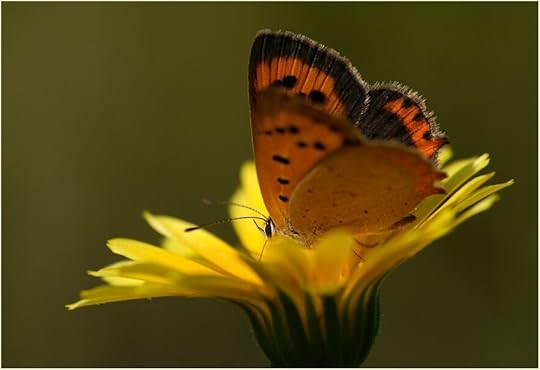 Back to the garden, think sustainable methods, like making compost, and practice organic gardening. Encourage beneficial insects, butterflies, and song birds to make their home in your yard. You'd be amazed how many you can attract just by planting a patch of sunflowers and zinnias.
Back to the garden, think sustainable methods, like making compost, and practice organic gardening. Encourage beneficial insects, butterflies, and song birds to make their home in your yard. You'd be amazed how many you can attract just by planting a patch of sunflowers and zinnias.
 Anything that rots and hasn't been sprayed with herbicide or pesticide can be used as mulch, although it's best to compost the material first. Old hay or straw make good mulch without needing to break down before using. Different parts of the country have various natural material that can be used. Organic matter feeds the soil and encourage earthworms. Remember, as I tell my children and now grandchildren, happy worms make happy dirt. Worms are the gardener's friend. Non-hybrid, heirloom seed can be saved for next year and shared with others, and old-time flowers can be divided and spread around.
Anything that rots and hasn't been sprayed with herbicide or pesticide can be used as mulch, although it's best to compost the material first. Old hay or straw make good mulch without needing to break down before using. Different parts of the country have various natural material that can be used. Organic matter feeds the soil and encourage earthworms. Remember, as I tell my children and now grandchildren, happy worms make happy dirt. Worms are the gardener's friend. Non-hybrid, heirloom seed can be saved for next year and shared with others, and old-time flowers can be divided and spread around.
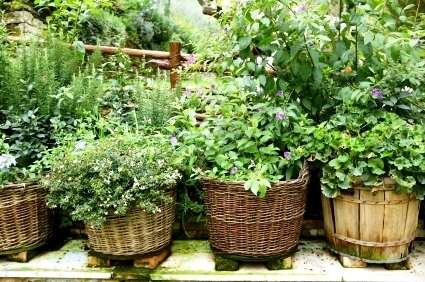 If digging in the earth isn't an option for you, try growing plants in pots on a patio, deck, rooftop, sunny windowsill, or under fluorescent lights. These can be fairly inexpensive to set up. I used to have a stand with long fluorescent lights suspended over it about 6-10 inches above the foliage. Raise the lights as the plants grow. You'll need warm and cool fluorescent bulbs for good plant growth, but not the more costly 'grow lights.' Although they're good too.
If digging in the earth isn't an option for you, try growing plants in pots on a patio, deck, rooftop, sunny windowsill, or under fluorescent lights. These can be fairly inexpensive to set up. I used to have a stand with long fluorescent lights suspended over it about 6-10 inches above the foliage. Raise the lights as the plants grow. You'll need warm and cool fluorescent bulbs for good plant growth, but not the more costly 'grow lights.' Although they're good too.
"No two gardens are the same. No two days are the same in one garden." ~Hugh Johnson
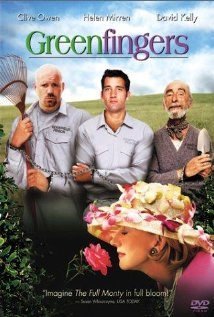 A film I really enjoyed about how gardening can reform and transform prisoners is Greenfingers with Clive Owen. The movie is based on a true story which makes it even better, and it's a love story, another plus, and the fabulous co-stars. I also really like actor . He's wonderful. The gardens featured are gorgeous and I never tire of looking at Clive. This is a feel good movie.
A film I really enjoyed about how gardening can reform and transform prisoners is Greenfingers with Clive Owen. The movie is based on a true story which makes it even better, and it's a love story, another plus, and the fabulous co-stars. I also really like actor . He's wonderful. The gardens featured are gorgeous and I never tire of looking at Clive. This is a feel good movie.
"Green fingers are the extension of a verdant heart. " ~Russell Page

Filed under: Uncategorized Tagged: Beneficial insects, Clive Owen, community garden, Community gardening, Compost, David Schwimmer, Garden, George Bernard Shaw, Greenfingers, Grow light, Growing Things (Children's Poolbeg), Heirloom plant, Helen Mirren, Home, Home and Garden, Hugh Johnson, Mulch, Personal, Plant, Plants, Russell Page, Sustainability, Trust, Vegetable








March 29, 2011
Agrimony~Healing Herb
 Agrimony: For a pleasant change from deadly poison, a post on this age-old healing herb. Used from ancient times to treat many ailments and injuries, it's also reputed to have magical properties.
Agrimony: For a pleasant change from deadly poison, a post on this age-old healing herb. Used from ancient times to treat many ailments and injuries, it's also reputed to have magical properties.
From my favorite source A Modern Herbal:
"The plant is found abundantly throughout England, on hedge-banks and the sides of fields, in dry thickets and on all waste places. In Scotland it is much more local and does not penetrate very far northward. (*It also grows in North America).
 Agrimony has an old reputation as a popular, domestic medicinal herb, being a simple well known to all country-folk. It belongs to the Rose order of plants, and its slender spikes of yellow flowers, which are in bloom from June to early September, and the singularly beautiful form of its much-cut-into leaves, make it one of the most graceful of our smaller herbs.
Agrimony has an old reputation as a popular, domestic medicinal herb, being a simple well known to all country-folk. It belongs to the Rose order of plants, and its slender spikes of yellow flowers, which are in bloom from June to early September, and the singularly beautiful form of its much-cut-into leaves, make it one of the most graceful of our smaller herbs.
The whole plant is deep green and covered with soft hairs, and has a slightly aromatic scent; even the small root is sweet scented, especially in spring. The spikes of flowers emit a most refreshing and spicy odour like that of apricots. The leaves when dry retain most of their fragrant odour, as well as the flowers, and Agrimony was once much sought after as a substitute or addition to tea, adding a peculiar delicacy and aroma to its flavour. Agrimony is one of the plants from the dried leaves of which in some country districts is brewed what is called 'a spring drink,' or 'diet drink,' a compound made by the infusion of several herbs and drunk in spring time as a purifier of the blood. In France, where herbal teas or tisanes are more employed than here, it is stated that Agrimony tea, for its fragrancy, as well as for its virtues, is often drunk as a beverage at table.
 The plant is subject to a considerable amount of variation, some specimens being far larger than others, much more clothed with hairs and with other minor differences. It has, therefore, by some botanists, been divided into two species, but the division is now scarcely maintained. The larger variety, having also a greater fragrance, was named Agrimonia odorata.
The plant is subject to a considerable amount of variation, some specimens being far larger than others, much more clothed with hairs and with other minor differences. It has, therefore, by some botanists, been divided into two species, but the division is now scarcely maintained. The larger variety, having also a greater fragrance, was named Agrimonia odorata.
*The image with the butterflies is from a site called Pennard Plants that sells old heirloom flower seeds.
 The long flower-spikes of Agrimony have caused the name of 'Church Steeples' to be given the plant in some parts of the country. It also bears the title of 'Cockeburr,' 'Sticklewort' or 'Stickwort,' because its seed-vessels cling by the hooked ends of their stiff hairs to any person or animal coming into contact with the plant. It was, Gerard informs us, at one time called Philanthropos, according to some old writers, on account of its beneficent and valuable properties, others saying that the name arose from the circumstance of the seeds clinging to the garments of passers-by, as if desirous of accompanying them, and Gerard inclines to this latter interpretation of the name.
The long flower-spikes of Agrimony have caused the name of 'Church Steeples' to be given the plant in some parts of the country. It also bears the title of 'Cockeburr,' 'Sticklewort' or 'Stickwort,' because its seed-vessels cling by the hooked ends of their stiff hairs to any person or animal coming into contact with the plant. It was, Gerard informs us, at one time called Philanthropos, according to some old writers, on account of its beneficent and valuable properties, others saying that the name arose from the circumstance of the seeds clinging to the garments of passers-by, as if desirous of accompanying them, and Gerard inclines to this latter interpretation of the name.
*Image above is from an interesting site Herbal Simples, about healing herbs.
The whole plant yields a yellow dye: when gathered in September, the colour given is pale, much like that called nankeen; later in the year the dye is of a darker hue and will dye wool of a deep yellow. As it gives a good dye at all times and is a common plant, easily cultivated, it seems to deserve the notice of dyers.
 History: The name Agrimony is from Argemone, a word given by the Greeks to plants which were healing to the eyes, the name Eupatoria refers to Mithridates Eupator, a king who was a renowned concoctor of herbal remedies. The magic power of Agrimony is mentioned in an old English medical manuscript:
History: The name Agrimony is from Argemone, a word given by the Greeks to plants which were healing to the eyes, the name Eupatoria refers to Mithridates Eupator, a king who was a renowned concoctor of herbal remedies. The magic power of Agrimony is mentioned in an old English medical manuscript:
'If it be leyd under mann's heed, He shal sleepyn as he were deed; He shal never drede ne wakyn,Till fro under his heed it be takyn.' (That's darn useful to know.)
*Image above is from another interesting herbal site called Every Green Herb.
 Agrimony was one of the most famous vulnerary herbs. (Vulnerary *is a plant used in the treatment of wounds). The Anglo-Saxons, who called it Garclive, taught that it would heal wounds, snake bites, warts, etc. In the time of Chaucer, when we find its name appearing in the form of Egrimoyne, it was used with Mugwort and vinegar for 'a bad back' and 'alle woundes': and one of these old writers recommends it to be taken with a mixture of pounded frogs and human blood, as a remedy for all internal hemorrhages."
Agrimony was one of the most famous vulnerary herbs. (Vulnerary *is a plant used in the treatment of wounds). The Anglo-Saxons, who called it Garclive, taught that it would heal wounds, snake bites, warts, etc. In the time of Chaucer, when we find its name appearing in the form of Egrimoyne, it was used with Mugwort and vinegar for 'a bad back' and 'alle woundes': and one of these old writers recommends it to be taken with a mixture of pounded frogs and human blood, as a remedy for all internal hemorrhages."
*I have to stop right here and comment. Pounded frogs and human blood mixed with Agrimony for all internal hemorrhages. Hmmm…it wonders me, as the Pennsylvania Dutch say, whose blood we're to mix in. Probably someone else's. And what would the proportions of pounded frog be to the herb and blood? No exact proportions given. Just a spoonful of this and a cup of that. I suspect it would take more than a spoonful of sugar to help that medicine go down.
I also like where the author goes on to say that Agrimony "has had a great reputation for curing jaundice and other liver complaints. Gerard believed in its efficacy. He says: 'A decoction of the leaves is good for them that have naughty livers.'" Got that? It treats naughty livers.
 Pliny called it an 'herb of princely authoritie.' Dioscorides stated that it was not only 'a remedy for them that have bad livers,' but also 'for such as are bitten with serpents.' Dr. Hill, who from 1751 to 1771 published several works on Herbal medicine, recommends 'an infusion of 6 oz. of the crown of the root in a quart of boiling water, sweetened with honey and half a pint drank three times a day,' as an effectual remedy for jaundice. It gives tone to the system and promotes assimilation of food."
Pliny called it an 'herb of princely authoritie.' Dioscorides stated that it was not only 'a remedy for them that have bad livers,' but also 'for such as are bitten with serpents.' Dr. Hill, who from 1751 to 1771 published several works on Herbal medicine, recommends 'an infusion of 6 oz. of the crown of the root in a quart of boiling water, sweetened with honey and half a pint drank three times a day,' as an effectual remedy for jaundice. It gives tone to the system and promotes assimilation of food."
Again from A Modern Herbal: It formed an ingredient of the famous arquebusade water as prepared against wounds inflicted by an arquebus, or hand-gun, and was mentioned by Philip de Comines, in his account of the battle of Morat in 1476. In France, the eau de arquebusade is still applied for sprains and bruises, being carefully made from many aromatic herbs.
 It was at one time included in the London Materia Medica as a vulnerary herb, but modern official medicine does not recognize its virtues, though it is still fully appreciated in herbal practice as a mild astringent and tonic, useful in coughs, diarrhea and relaxed bowels. By pouring a pint of boiling water on a handful of the dried herb – stem, leaves and flowers – an excellent gargle may be made for a relaxed throat, and a teacupful of the same infusion is recommended, taken cold three or four times in the day for looseness in the bowels, also for passive losses of blood. It may be given either in infusion or decoction.
It was at one time included in the London Materia Medica as a vulnerary herb, but modern official medicine does not recognize its virtues, though it is still fully appreciated in herbal practice as a mild astringent and tonic, useful in coughs, diarrhea and relaxed bowels. By pouring a pint of boiling water on a handful of the dried herb – stem, leaves and flowers – an excellent gargle may be made for a relaxed throat, and a teacupful of the same infusion is recommended, taken cold three or four times in the day for looseness in the bowels, also for passive losses of blood. It may be given either in infusion or decoction.
Constituents: Agrimony contains a particular volatile oil, which may be obtained from the plant by distillation and also a bitter principle. It yields in addition 5 per cent of tannin, so that its use in cottage medicine for gargles and as an astringent applicant to indolent ulcers and wounds is well justified. Owing to this presence of tannin, its use has been recommended in dressing leather.
Agrimony is also considered a very useful agent in skin eruptions and diseases of the blood, pimples, blotches, etc. A strong decoction of the root and leaves, sweetened with honey or sugar, has been taken successfully to cure scrofulous sores, being administered two or three times a day, in doses of a wineglassful, persistently for several months. The same decoction is also often employed in rural districts as an application to ulcers.
Preparation: In North America, it is said to be used in fevers with great success, by the Indians and Canadians.
In former days, it was sometimes given as a vermifuge, (*serving to expel worms and other parasites from the intestinal tract) though that use is obsolete.
 In the Middle Ages, it was said to have magic powers, if laid under a man's head inducing heavy sleep till removed, but no narcotic properties are ascribed to it.
In the Middle Ages, it was said to have magic powers, if laid under a man's head inducing heavy sleep till removed, but no narcotic properties are ascribed to it.
(Image of the medieval herb garden at Ypres Tower is from this site)
Green (Universal Herbal, 1832) tells us that 'its root appears to possess the properties of Peruvian bark in a very considerable degree, without manifesting any of its inconvenient qualities, and if taken in pretty large doses, either in decoction or powder, seldom fails to cure the ague.'
 Culpepper (1652) recommends it, in addition to the uses already enumerated, for gout, 'either used outwardly in an oil or ointment, or inwardly, in an electuary or syrup, or concreted juice.' He praises its use externally, stating how sores may be cured 'by bathing and fomenting them with a decoction of this plant,' and that it heals 'all inward wounds, bruises, hurts and other distempers.' He continues: 'The decoction of the herb, made with wine and drunk, is good against the biting and stinging of serpents . . . it also helpeth the colic, cleanseth the breath and relieves the cough. A draught of the decoction taken warm before the fit first relieves and in time removes the tertian and quartian ague.' It 'draweth forth thorns, splinters of wood, or any such thing in the flesh. It helpeth to strengthen members that are out of joint.'"
Culpepper (1652) recommends it, in addition to the uses already enumerated, for gout, 'either used outwardly in an oil or ointment, or inwardly, in an electuary or syrup, or concreted juice.' He praises its use externally, stating how sores may be cured 'by bathing and fomenting them with a decoction of this plant,' and that it heals 'all inward wounds, bruises, hurts and other distempers.' He continues: 'The decoction of the herb, made with wine and drunk, is good against the biting and stinging of serpents . . . it also helpeth the colic, cleanseth the breath and relieves the cough. A draught of the decoction taken warm before the fit first relieves and in time removes the tertian and quartian ague.' It 'draweth forth thorns, splinters of wood, or any such thing in the flesh. It helpeth to strengthen members that are out of joint.'"
 From Herb Magic.com: "AGRIMONY is an herb that is said to turn back jinxes that have already been made, roots that have already been laid, and curses that have already been cast. Combined with Slippery Elm Bark, it is said to break spells involving Slander and Lies…combined with Rue, it is said to send back the Evil Eye (Mal Occhio) even after the Eye has already taken effect. Combined with Salt, it is said to un-make Hexes and Witchcraft." They add, "We make no claims for AGRIMONY, and sell it as a Curio only."
From Herb Magic.com: "AGRIMONY is an herb that is said to turn back jinxes that have already been made, roots that have already been laid, and curses that have already been cast. Combined with Slippery Elm Bark, it is said to break spells involving Slander and Lies…combined with Rue, it is said to send back the Evil Eye (Mal Occhio) even after the Eye has already taken effect. Combined with Salt, it is said to un-make Hexes and Witchcraft." They add, "We make no claims for AGRIMONY, and sell it as a Curio only."
*I make no claims either and am only quoting from and commenting on what I've researched. 
 This is a terrific site: The Medieval Gardener:
This is a terrific site: The Medieval Gardener:
Regarding Agrimony it says: "This perennial with its tall yellow spires (to 24 inches) is a native European plant often found growing wild in the Middle Ages. Recorded in the inventories of Charlemagne's gardens (but not in the Capitulare de Villis ) and the Anglo Saxon dictionary source of Aelfric, it was highly regarded for its general healing and magical powers and was believed by the Anglo Saxons to heal wounds, warts and snake bites. If laid under a pillow, they further believed it had magical powers to induce a deep sleep until removal. Another 14th century reference claims it for the treatment of back problems along with mugwort and vinegar. Agrimony was also used as a strewing herb and, bundled with rue, broom, maidenhair and ground ivy, was used to identify witches. Today we are aware of the tannin content of agrimony and use its lovely apricot scented dried flowers and leaves to make herbal teas as well as astringent infusions, and to attract bees in the garden." ~ Contributed by B. F. Wedlake
 *Several herbal related excerpts from my Historical Fantasy Romance Daughter of the Wind. This excerpt is from the old Scotswoman, Neeley's, point of view.
*Several herbal related excerpts from my Historical Fantasy Romance Daughter of the Wind. This excerpt is from the old Scotswoman, Neeley's, point of view.
'A brooding darkness hovered over the McNeal homestead. Of that, Neeley was certain. And she sensed from where it came. She needed all her wisdom now to prevail against it. She'd limped stiffly through the home sprinkling a sweetly aromatic decoction of angelica root into every corner, the most powerful herb for warding off spells and enchantment. Then she'd hung a bough of rowan wood above the doorway to lend protection from evil. The leafless branch dripped with clusters of orange-red berries, pleasant to behold as she sat by the hearth."~
 And later in the chapter, 'Her needle winking in the firelight, Neeley sewed the blue fringe on the cape collar and around the long hem. The fragrance of angelica, the most sacred of herbs, rose from the linen. She'd sprinkled a decoction of the holy root over the cloth to bring protection to the wearer. Jack would need all the defense he could get.
And later in the chapter, 'Her needle winking in the firelight, Neeley sewed the blue fringe on the cape collar and around the long hem. The fragrance of angelica, the most sacred of herbs, rose from the linen. She'd sprinkled a decoction of the holy root over the cloth to bring protection to the wearer. Jack would need all the defense he could get.
As for Karin, her innate goodness would aid her, but Neeley wasn't taking any chances. An herbal bath of angelica mingled with the purifying power of agrimony, redolent of ripe apricots, awaited the girl. Jack too, if Neeley managed to coax him in.'~
 This excerpt is from the heroine's point of view:
This excerpt is from the heroine's point of view:
'Neeley rose stiffly from her chair and shuffled forward, her stooped figure a head shorter than Karin's. "You'll want my help, John McNeal. Fetch the woundwort, Karin. Sarah, steep some comfrey in hot water and bring fresh linens. Joseph, the poor fellow could do with a spot of brandy," the tiny woman rapped out like a hammer driving nails. Old, she might be, and as wizened as a dried apple, but Neeley took charge in a medical emergency whether folks liked it or not.
Sarah dashed to the cupboard to take down the brown bowl. Karin flew beside her and grabbed the crock reeking of salve. Sarah snatched a towel and they spun toward the hearth as the men made their way past the gaping crowd. The stranger lifted his head and looked dazedly at both women. Karin met vivid green eyes in a sun-bronzed face stubbled with dark whiskers. A fiery sensation shot through her—and not just because he was devastatingly handsome.'~
 The two following excerpts are from the hero, Jack's, point of view.
The two following excerpts are from the hero, Jack's, point of view.
'"Thomas, see Sarah gets to bed and brew her a cup of betony. That'll calm her," Neeley directed.
Thomas helped his stepmother to her feet."Come on, Sarah. You'll do better with a rest and some tea," he said, and guided the unsteady woman from the room.
Neeley set the white porcelain bowl on the washstand. She squinted down at Jack and then gestured with bent fingers at the girl peering from behind John's bulk. "Karin, come closer. You're my hands, lass."
Her eyes, too, Jack suspected.'~
 And later in that scene, 'Karin dabbed his shoulder dry, then dipped her small hand into the pungent crock. Pursing rose-tinged lips, she smeared the aromatic paste on his wound. "I'll give the salve a while to work before I dig the ball out and stitch you up. Ever had woundwort, sir?"
And later in that scene, 'Karin dabbed his shoulder dry, then dipped her small hand into the pungent crock. Pursing rose-tinged lips, she smeared the aromatic paste on his wound. "I'll give the salve a while to work before I dig the ball out and stitch you up. Ever had woundwort, sir?"
"Dulls the pain right well," Jack managed, hiding a grimace. Even her soft touch stung like the devil, but he wouldn't push her away for anything.'~
I use herbs in all of my stories, but some more than others. 
 The greatest gift of the garden is the restoration of the five senses. ~Hanna Rion
The greatest gift of the garden is the restoration of the five senses. ~Hanna Rion
Filed under: Uncategorized Tagged: Agrimonia, ancient herb, Anglo-Saxon, healing herb, Health, Herb, herbal excerpts, Herbalism, herbs grown in the middle ages, herbs used in novels, Historical fantasy romance, historical romance novel excerpts, Maud Grieve, medieval herbs, Odor, Pennsylvania Dutch, Shopping








March 28, 2011
"No matter how long the winter, spring is sure to follow." ~Proverb
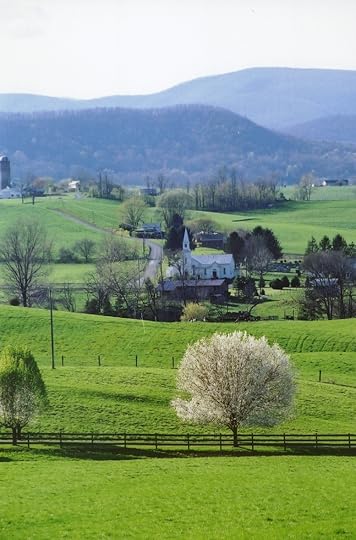 March is a 'right mixy' month, to use a country expression. Last week's balmy warmth was followed by snow and today is cold, cold, cold, followed by a projected warm spell and then more snow to round out this month of extreme weather contrasts. But that's early spring in the Shenandoah Valley.
March is a 'right mixy' month, to use a country expression. Last week's balmy warmth was followed by snow and today is cold, cold, cold, followed by a projected warm spell and then more snow to round out this month of extreme weather contrasts. But that's early spring in the Shenandoah Valley.
I grieve for the foolish apricot tree lured into bloom by the warmth, then zapped by the returning chill. This happens nearly every spring, except last year when we had a lovely luscious crop. And the tulip leaves are looking sad, but I hope they'll revive. The best cure for a cold snap is a soothing wash of warm spring rain.
 For some reason, the birds have nibbled the blooms on the pussy willow to bits. And I feed the birds. The feeder hangs from the remains of the old cherry tree not far removed from the pussy willow. My solution is to root pussy willow cuttings and plant them somewhere else. Apparently the birds like some fresh greens along with their sunflower seeds and soft silvery little 'pussies' will serve. Who knew? But I love catkins so will tuck some in an out-of-the-way corner. Perhaps down near the pond. I also love my birds, and kitties (big bird fans). Sometimes our loves do not meld well.
For some reason, the birds have nibbled the blooms on the pussy willow to bits. And I feed the birds. The feeder hangs from the remains of the old cherry tree not far removed from the pussy willow. My solution is to root pussy willow cuttings and plant them somewhere else. Apparently the birds like some fresh greens along with their sunflower seeds and soft silvery little 'pussies' will serve. Who knew? But I love catkins so will tuck some in an out-of-the-way corner. Perhaps down near the pond. I also love my birds, and kitties (big bird fans). Sometimes our loves do not meld well.
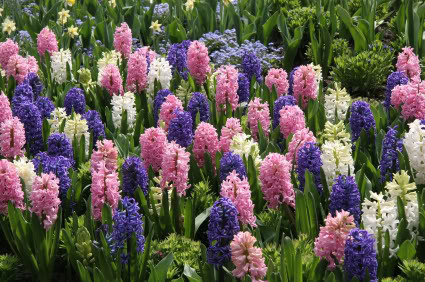 "It's spring fever. That is what the name of it is. And when you've got it, you want – oh, you don't quite know what it is you do want, but it just fairly makes your heart ache, you want it so! ~Mark Twain
"It's spring fever. That is what the name of it is. And when you've got it, you want – oh, you don't quite know what it is you do want, but it just fairly makes your heart ache, you want it so! ~Mark Twain
"Spring is when you feel like whistling even with a shoe full of slush." ~Doug Larson
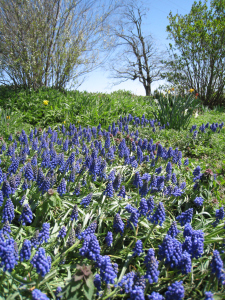 "If we had no winter, the spring would not be so pleasant; if we did not sometimes taste of adversity, prosperity would not be so welcome." ~Anne Bradstreet
"If we had no winter, the spring would not be so pleasant; if we did not sometimes taste of adversity, prosperity would not be so welcome." ~Anne Bradstreet
"No winter lasts forever; no spring skips its turn." ~Hal Borland
"Spring shows what God can do with a drab and dirty world." ~Virgil A. Kraft
"Where man sees but withered leaves,
God sees sweet flowers growing."
~Albert Laighton
 "In the spring, at the end of the day, you should smell like dirt." ~Margaret Atwood
"In the spring, at the end of the day, you should smell like dirt." ~Margaret Atwood
"It was one of those March days when the sun shines hot and the wind blows cold: when it is summer in the light, and winter in the shade." ~Charles Dickens
"In the spring I have counted one hundred and thirty-six different kinds of weather inside of four and twenty hours." ~Mark Twain
*Pics of the Shenandoah Valley, my garden, and our gosling and kitten taken by my mom and daughter Elise.
Filed under: Uncategorized Tagged: Anne Bradstreet, Apricot, Bird, Catkin, Charles Dickens, Easter, Garden, God, gosling, Hal Borland, Margaret Atwood, Mark Twain, Middle Ages, New England, Pussy willow, Shenandoah Valley, Virginia, Weather, Willow








March 26, 2011
Herbal Lore, History, and Allergies
 Being passionate about the past, I relish a connection to those who've gone before us. I'm fascinated with history and love old homes, historic sites, all that ties us to the richness of bygone ages. Intrigued with herbal lore, I often use it in my writing. Herbs influenced every facet of life in pre-modern times and have changed little over the centuries. When I hold an aromatic sprig of rosemary in my hand, I'm touching the same plant beloved by the ancients. Some heirloom roses hail from the glory days of Rome.
Being passionate about the past, I relish a connection to those who've gone before us. I'm fascinated with history and love old homes, historic sites, all that ties us to the richness of bygone ages. Intrigued with herbal lore, I often use it in my writing. Herbs influenced every facet of life in pre-modern times and have changed little over the centuries. When I hold an aromatic sprig of rosemary in my hand, I'm touching the same plant beloved by the ancients. Some heirloom roses hail from the glory days of Rome.
To further that sense of oneness, and for their many uses, I grow a variety of herbs. Thyme, basil, sage, and chives are a few in my kitchen garden. Lavender and scented geraniums are wonderful for their scent alone. Ladies once wafted the delicate perfume of toilet water. Porcelain bowls filled with colorful potpourri scented musty parlors.
 Before taking the leap into penning novels, I wrote vignettes on rural life. I've compiled these into a work of non-fiction and may self-publish. At one time, I also had a modest herb business and gave talks on herbal lore to local groups much as Julia Maury did in my light paranormal romance Somewhere My Love.
Before taking the leap into penning novels, I wrote vignettes on rural life. I've compiled these into a work of non-fiction and may self-publish. At one time, I also had a modest herb business and gave talks on herbal lore to local groups much as Julia Maury did in my light paranormal romance Somewhere My Love.
 Back to my herbal enterprise, with the faithful assistance of my long-suffering mother we grew and dried herbs and flowers for wreath making and potpourri which we sold in the fall. Herbs and heirloom flower seedlings were raised in the small greenhouse my hubby built me and sold in the spring. Any profits were swiftly overrun by subsequent visits to the allergist,whom I've seen regularly for years now and still get four shots at a crack. It seems I developed every allergy latent within me by exposure to all these pollens. *Note, If you're allergic to ragweed, avoid an herb called Sweet Annie and the Artemisia family. But I'm considered to rank in the top ten percent of allergy sufferers in the nation, so what are the odds of that?
Back to my herbal enterprise, with the faithful assistance of my long-suffering mother we grew and dried herbs and flowers for wreath making and potpourri which we sold in the fall. Herbs and heirloom flower seedlings were raised in the small greenhouse my hubby built me and sold in the spring. Any profits were swiftly overrun by subsequent visits to the allergist,whom I've seen regularly for years now and still get four shots at a crack. It seems I developed every allergy latent within me by exposure to all these pollens. *Note, If you're allergic to ragweed, avoid an herb called Sweet Annie and the Artemisia family. But I'm considered to rank in the top ten percent of allergy sufferers in the nation, so what are the odds of that?
 After being run indoors and my gardening curtailed, I took up writing and have used my love of plants there. I'm still an avid gardener, though with shots, meds and limits. Is it spring yet? My nose says yes.
After being run indoors and my gardening curtailed, I took up writing and have used my love of plants there. I'm still an avid gardener, though with shots, meds and limits. Is it spring yet? My nose says yes. 
Filed under: Uncategorized Tagged: Allergy, Artemisia, cottage industry, Herb, Herbal, Kitchen garden, Lara's Theme, Odor, Rome, Shopping








March 25, 2011
Belladonna
 Belladonna (Deadly Nightshade)
Belladonna (Deadly Nightshade)
"In Italian, a belladonna is a beautiful lady; in English it's a deadly poison." ~ Ambrose Bierce
Alternate name for Belladonna: Devil's Cherries, Naughty Man's Cherries, Divale, Black Cherry, Devil's Herb, Great Morel, Dwayberry.
The Atropa genus (that Atropa belladonna belongs to) is a member of the Solanaceae (the nightshade or potato) family of plants which includes brugmansia, capsicum (used to make paprika and chili pepper), eggplant, jimsonweed, mandrake, petunia, potato, tobacco, and tomato plants.
 Belladonna has a fascinating history and uses. All parts of the plant are potentially toxic, including the berries, and it's made into a liquid extract which can be administered. The toxin is also absorbed through the skin.
Belladonna has a fascinating history and uses. All parts of the plant are potentially toxic, including the berries, and it's made into a liquid extract which can be administered. The toxin is also absorbed through the skin.
From Rodale's Illustrated Encyclopedia of Herbs: "During the Middle Ages, men and women believed that deadly nightshade was the favorite plant of the devil. This is not surprising when one considers the stories told of this plant. Belladonna was said to be an ingredient in the refreshments of wild orgies at which women would strip off their clothes, dance, and throw themselves into the arms of eager men. Sorcerers and witches added the juices of the plant to their brews and ointments. Witches rubbed a lotion containing belladonna and aconite into their skin believing that it helped them to fly. Given the physiological effects of both of these herbs, in a way it probably did make them fly. Deadly nightshade's toxicity did not go unnoticed either. Men used this herb frequently to kill."
 From A Modern Herbal:
From A Modern Herbal:
Habitat: Widely distributed over Central and Southern Europe, South-west Asia and Algeria; cultivated in England, France and North America.
Description: The root is thick, fleshy and whitish, about 6 inches long, or more, and branching. It is perennial. The purplish-coloured stem is annual and herbaceous. It is stout, 2 to 4 feet high, undivided at the base, but dividing a little above the ground into three – more rarely two or four branches, each of which again branches freely.
The leaves are dull, darkish green in colour and of unequal size, 3 to 10 inches long, the lower leaves solitary, the upper ones in pairs alternately from opposite sides of the stem, one leaf of each pair much larger than the other, oval in shape, acute at the apex, entire and attenuated into short petioles…the fresh plant, when crushed, exhales a disagreeable odour, almost disappearing on drying, and the leaves have a bitter taste, when both fresh and dry.
 The flowers, which appear in June and July, singly, in the axils of the leaves, and continue blooming until early September, are of a dark and dingy purplish colour, tinged with green, large (about an inch long), pendent, bell-shaped, furrowed, the corolla with five large teeth or lobes, slightly reflexed. The five-cleft calyx spreads round the base of the smooth berry, which ripens in September, when it acquires a shining black colour and is in size like a small cherry. It contains several seeds. The berries are full of a dark, inky juice, and are intensely sweet, and their attraction to children on that account, has from their poisonous properties, been attended with fatal results.
The flowers, which appear in June and July, singly, in the axils of the leaves, and continue blooming until early September, are of a dark and dingy purplish colour, tinged with green, large (about an inch long), pendent, bell-shaped, furrowed, the corolla with five large teeth or lobes, slightly reflexed. The five-cleft calyx spreads round the base of the smooth berry, which ripens in September, when it acquires a shining black colour and is in size like a small cherry. It contains several seeds. The berries are full of a dark, inky juice, and are intensely sweet, and their attraction to children on that account, has from their poisonous properties, been attended with fatal results.
 Lyte urges growers 'to be carefull to see to it and to close it in, that no body enter into the place where it groweth, that wilbe enticed with the beautie of the fruite to eate thereof.' And Gerard, writing twenty years later, after recounting three cases of poisoning from eating the berries, exhorts us to 'banish therefore these pernicious plants out of your gardens and all places neare to your houses where children do resort.' In September, 1916, three children were admitted to a London hospital suffering from Belladonna poisoning, caused, it was ascertained, from having eaten berries from large fruiting plants of Atropa Belladonna growing in a neighbouring public garden, the gardener being unaware of their dangerous nature, and again in 1921 the Norwich Coroner, commenting on the death of a child from the same cause, said that he had had four not dissimilar cases previously.
Lyte urges growers 'to be carefull to see to it and to close it in, that no body enter into the place where it groweth, that wilbe enticed with the beautie of the fruite to eate thereof.' And Gerard, writing twenty years later, after recounting three cases of poisoning from eating the berries, exhorts us to 'banish therefore these pernicious plants out of your gardens and all places neare to your houses where children do resort.' In September, 1916, three children were admitted to a London hospital suffering from Belladonna poisoning, caused, it was ascertained, from having eaten berries from large fruiting plants of Atropa Belladonna growing in a neighbouring public garden, the gardener being unaware of their dangerous nature, and again in 1921 the Norwich Coroner, commenting on the death of a child from the same cause, said that he had had four not dissimilar cases previously.
 It is said that when taken by accident, the poisonous effects of Belladonna berries may be prevented by swallowing as soon as possible an emetic, such as a large glass of warm vinegar or mustard and water. In undoubted cases of this poisoning, emetics and the stomach-pump are resorted to at once, followed by a dose of magnesia, stimulants and strong coffee, the patient being kept very warm and artificial respiration being applied if necessary. A peculiar symptom in those poisoned by Belladonna is the complete loss of voice, together with frequent bending forward of the trunk and continual movements of the hands and fingers, the pupils of the eye becoming much dilated.
It is said that when taken by accident, the poisonous effects of Belladonna berries may be prevented by swallowing as soon as possible an emetic, such as a large glass of warm vinegar or mustard and water. In undoubted cases of this poisoning, emetics and the stomach-pump are resorted to at once, followed by a dose of magnesia, stimulants and strong coffee, the patient being kept very warm and artificial respiration being applied if necessary. A peculiar symptom in those poisoned by Belladonna is the complete loss of voice, together with frequent bending forward of the trunk and continual movements of the hands and fingers, the pupils of the eye becoming much dilated.
 History: The plant in Chaucer's days was known as Dwale, which Dr. J. A. H. Murray considers was probably derived from the Scandinavian dool, meaning delay or sleep. Other authorities have derived the word from the French deuil (grief), a reference to its fatal properties.
History: The plant in Chaucer's days was known as Dwale, which Dr. J. A. H. Murray considers was probably derived from the Scandinavian dool, meaning delay or sleep. Other authorities have derived the word from the French deuil (grief), a reference to its fatal properties.
Its deadly character is due to the presence of an alkaloid, Atropine, 1/10 grain of which swallowed by a man has occasioned symptoms of poisoning. As every part of the plant is extremely poisonous, neither leaves, berries, nor root should be handled if there are any cuts or abrasions on the hands. The root is the most poisonous, the leaves and flowers less so, and the berries, except to children, least of all. It is said that an adult may eat two or three berries without injury, but dangerous symptoms appear if more are taken, and it is wiser not to attempt the experiment. Though so powerful in its action on the human body, the plant seems to affect some of the lower animals but little. Eight pounds of the herb are said to have been eaten by a horse without causing any injury, and an ass swallowed 1 lb. of the ripe berries without any bad results following. Rabbits, sheep, goats and swine eat the leaves with impunity, and birds often eat the seeds without any apparent effect, but cats and dogs are very susceptible to the poison.
 Belladonna is supposed to have been the plant that poisoned the troops of Marcus Antonius during the Parthian wars. Plutarch gives a graphic account of the strange effects that followed its use.
Belladonna is supposed to have been the plant that poisoned the troops of Marcus Antonius during the Parthian wars. Plutarch gives a graphic account of the strange effects that followed its use.
Buchanan relates in his History of Scotland (1582) a tradition that when Duncan I was King of Scotland, the soldiers of Macbeth poisoned a whole army of invading Danes by a liquor mixed with an infusion of Dwale supplied to them during a truce. Suspecting nothing, the invaders drank deeply and were easily overpowered and murdered in their sleep by the Scots.
 According to old legends, the plant belongs to the devil who goes about trimming and tending it in his leisure, and can only be diverted from its care on one night in the year, that is on Walpurgis, when he is preparing for the witches' sabbath. The apples of Sodom are held to be related to this plant, and the name Belladonna is said to record an old superstition that at certain times it takes the form of an enchantress of exceeding loveliness, whom it is dangerous to look upon, though a more generally accepted view is that the name was bestowed on it because its juice was used by the Italian ladies to give their eyes greater brilliancy, the smallest quantity having the effect of dilating the pupils of the eye.
According to old legends, the plant belongs to the devil who goes about trimming and tending it in his leisure, and can only be diverted from its care on one night in the year, that is on Walpurgis, when he is preparing for the witches' sabbath. The apples of Sodom are held to be related to this plant, and the name Belladonna is said to record an old superstition that at certain times it takes the form of an enchantress of exceeding loveliness, whom it is dangerous to look upon, though a more generally accepted view is that the name was bestowed on it because its juice was used by the Italian ladies to give their eyes greater brilliancy, the smallest quantity having the effect of dilating the pupils of the eye.
 Another derivation is founded on the old tradition that the priests used to drink an infusion before they worshipped and invoked the aid of Bellona, the Goddess of War.
Another derivation is founded on the old tradition that the priests used to drink an infusion before they worshipped and invoked the aid of Bellona, the Goddess of War.
The generic name of the plant, Atropa, is derived from the Greek Atropos, one of the Fates who held the shears to cut the thread of human life – a reference to its deadly, poisonous nature.
Thomas Lupton (1585) says: 'Dwale makes one to sleep while he is cut or burnt by cauterizing.' Gerard (1597) calls the plant the Sleeping Nightshade, and says the leaves moistened in wine vinegar and laid on the head induce sleep.
 Mandrake, a foreign species of Atropa (A. Mandragora), was used in Pliny's day as an anesthetic for operations. Its root contains an alkaloid, Mandragorine. The sleeping potion of Juliet was a preparation from this plant – perhaps also the Mandrake wine of the Ancients. It was called Circaeon, being the wine of Circe.
Mandrake, a foreign species of Atropa (A. Mandragora), was used in Pliny's day as an anesthetic for operations. Its root contains an alkaloid, Mandragorine. The sleeping potion of Juliet was a preparation from this plant – perhaps also the Mandrake wine of the Ancients. It was called Circaeon, being the wine of Circe.
Mandrake, the screaming roots in Harry Potter, is related to Belladonna.
Filed under: Uncategorized Tagged: Atropa, Atropa belladonna, Black Cherry, Dwale, Herb, Middle Ages, Poison, Prunus serotina, Solanaceae, Southern Europe








March 24, 2011
For Duck Lovers
 The ducks are assembling on the river at my parent's house and their old friend is back, and possibly his original mom. Those of you who remember my post last summer about The Duck Who Thinks He's A Chicken will appreciate these pics she took. His hen mother isn't in them, but I don't think she'll mind.
The ducks are assembling on the river at my parent's house and their old friend is back, and possibly his original mom. Those of you who remember my post last summer about The Duck Who Thinks He's A Chicken will appreciate these pics she took. His hen mother isn't in them, but I don't think she'll mind.
 "If it walks like a duck, quacks like a duck, looks like a duck, it must be a duck." ~Proverb
"If it walks like a duck, quacks like a duck, looks like a duck, it must be a duck." ~Proverb
"If it looks like a duck, and quacks like a duck, we have to at least consider the possibility that we have a small aquatic bird of the family anatidae on our hands." ~Douglas Adams, British comic/ writer
Filed under: Uncategorized Tagged: Douglas Adams, Duck, duck lovers, Duck test, Home, Poultry, Quackery, rural life










